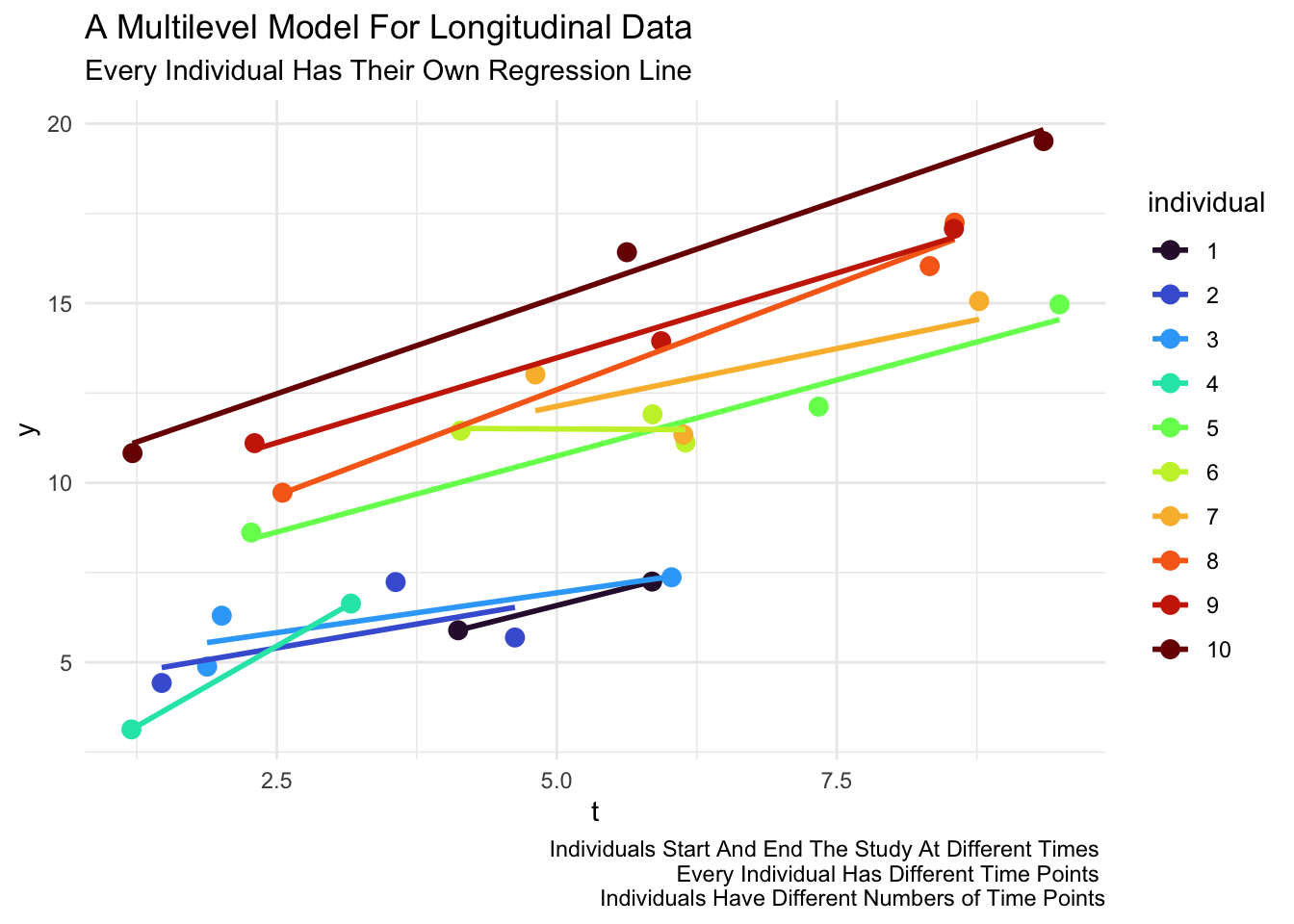Why Multilevel Models Are Good Models For Longitudinal Data
Multilevel Models Offer An Incredibly Flexible Treatment of Time and Time Varying Processes and Covariates
1 Key Idea
Multilevel models are uniquely suited for complicated longitudinal data and research designs. Among other advantages, multilevel models are able to easily accommodate designs where individuals are observed at different times and different numbers of times.1
2 Visually
3 Data Structures
Multilevel models for longitudinal data prefer data in long format.
| id | x1 | x2 | x3 | y1 | y2 | y3 |
|---|---|---|---|---|---|---|
| 1 | ||||||
| 2 | ||||||
| 3 |
| id | t | x | y |
|---|---|---|---|
| 1 | 1 | ||
| 1 | 2 | ||
| 1 | 3 | ||
| 2 | 1 | ||
| 2 | 2 | ||
| 2 | 3 | ||
| 3 | 1 | ||
| 3 | 2 | ||
| 3 | 3 |
4 Equation
\[y_{it} = \beta_0 + \beta_1 t_{it} + \beta_2 x_{it} + u_{0i} + e_{it} \tag{1}\]
Every row is a person-observation (person i observed at time t). Every person has multiple rows.
5 Advantages of the Multilevel Model for Longitudinal Data
- Using the algebra in Equation 1, these models can easily accommodate both time varying and time invariant variables (Hox, 2010; Hox et al., 2018; Rabe-Hesketh & Skrondal, 2022; Raudenbush & Bryk, 2002; Singer & Willett, 2003).
- There is no multicollinearity issue with multiple \(\beta\) coefficients for multiple waves of data. By inspection of Equation 1, we see that there is only a single \(\beta\) coefficient for each variable, \(\therefore\) no multicollinearity problem.
- Unbalanced data is less of a problem, the data structure and estimation are robust to these possibilities (Raudenbush, 1995; Raudenbush & Bryk, 2002; Singer & Willett, 2003).
- Missing data is less of a problem (assuming MCAR). When a person observation is missing, that person simply has fewer rows of data (Hox, 2010; Luke, 2004; Rabe-Hesketh & Skrondal, 2022; Raudenbush, 1995; Raudenbush & Bryk, 2002). But all rows of data are “matched” to the same person by \(i\).
- We have an explicit function of time \(\beta_1 t\), and could treat time more flexibly, by creating a polynomial function of time e.g. by adding \(\beta_2 t^2\), etc. (Raudenbush & Bryk, 2002; Singer & Willett, 2003). (We could even substitute \(\beta \ln(t)\).)
- Again, by inspection of Equation 1, we see that multiple or many time-points are not a problem. We would use the same algebra for 2 time points or for 10,000 time points. (Helpful when we start to think about intensive longitudinal data e.g. George Holden’s recording study).
- We are measuring exactly the time at which events take place for each individual (Luke, 2004; Singer & Willett, 2003). Not simply saying Wave 1, Wave 2, Wave 3, etc…
- Unequally spaced time points are not a problem (Raudenbush, 1995). Every individual could have a completely different set of time points and even a completely different number of time points (Hox, 2010; Hox et al., 2018; Luke, 2004; Singer & Willett, 2003).
We do need to think carefully about what is the appropriate variable for time. Is it the variable we used to reshape the data–often wave–or some other more appropriate metric, like age or time in study (Singer & Willett, 2003)?
6 References
Footnotes
Many, if not most, of the advantages listed in this handout will also apply to any approach using long data.↩︎
Citation
@online{grogan-kaylor2025,
author = {Grogan-Kaylor, Andy},
title = {Why {Multilevel} {Models} {Are} {Good} {Models} {For}
{Longitudinal} {Data}},
date = {2025-12-04},
url = {agrogan1.github.io/multilevel/MLM-longitudinal-data/why-MLMs-are-good-models-for-longitudinal-data.html},
langid = {en}
}
